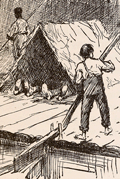|
The people are eagerly welcoming Mark Twain's new book; even now Mr. John Bliss is taking subscriptions in Hartford--work contemporary to similar work all over the country--for this latest contribution to the droll. Before the reader hardly gets upon the threshold he is confronted with the humor of the author. Read this notice: "Persons attempting to find a motive in this narrative will be prosecuted, persons attempting to find a moral in it will be banished; persons attempting to find a plot in it will be shot. By order of the author, per G.G., chief or ordnance." On the sheet just previous, the representation of personified humor appears in a fine heliotype of Karl Gerhardt's profile bust of Mr. Clemmens [sic]; the frontispiece is the same subject's other ego in part--if a transfusion of literary life may constitute this--to wit: a full length of Huckleberry Finn, himself, smiling, holding up a dead rabbit in one hand while a gun in the other reveals the weapon of slaughter. The author explains, to correct the possible impression that all the characters were trying to talk alike without succeeding--that he has used a number of dialects, to wit, the Missouri negro dialect; the extremest form of the backwards South-Western dialect; the ordinary "Pike county" dialect; and four modified varieties of the last. "The shadings," he says, "have not been done in a hap-hazard fashion, or by guess work; but painstakingly, and with the trustworthy guidance and support of personal familiarity with these several forms of speech." As a storehouse therefore of dialect, even more than as a book of humor, the volume is valuable. What if the trans-Atlantic critics with their usual keen appreciation should find this the overpowering merit of the book? There are many pleasant episodes, innumerable original characters, situations so exceedingly droll that one denounces over again with added emphasis as absurdly false the pessimistic idea that the best things have already been said; here is a garden replete with new varieties. It would not be fair to the expectant reader (to be numbered by the thousand) to give any outline of the narrative, save in the briefest manner. "Huckleberry" is a bad boy and a sharp one, who makes many acquaintances in his island retreats and river wanderings and finally assists in stealing an ante-bellum "nigger"--a philanthropic act that will long keep his memory green. The "He had a rat" story put into a funeral scene, where it actually occurred in this city, will be recognized by a number of Hartford people, who have had many hearty laughs at it in its chrysalis period. Translated into Mr. Twain's sublimated prose atmosphere, it will be looked for with eagerness. There are 174 illustrations in the book. Most of them are well designed and executed. They are on the average very expressive and calculated to explain the text to a nicety. We have to find fault here with only one thing about Huckleberry Finn--Mr. Clemmens leads us to presume by a drawing or two to be found on the closing pages that somebody is going to die, and then he grossly disappoints us by letting him live. Of course we know the "good die young," but that has been shown to be an exploded fallacy--as a generalization that is; the "bad die young" is an apothegm more in accordance with scientific and biblical truth. The hero of these 366 pages would have lived not less altogether in vain than is now the fact had he been killed by indignant citizens. |

